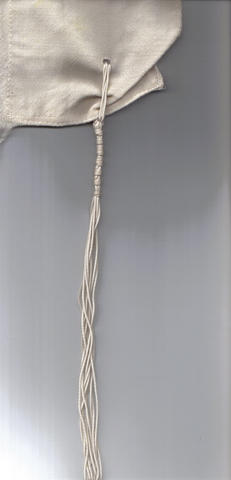Tzitzit
Tzitzit (Hebrew: ציצית) are specially knotted ritual fringes, or tassels, worn in Judaism by observant Jews. The tzitzit are attached to the four corners of the tallit (prayer shawl) and tallit katan (small tallit), garments worn as a reminder of the commandments of the Torah. The practice is derived from the commandment in the Torah found in Numbers 15:38-39 and Deuteronomy 22:12, which instructs the children of Israel to attach fringes to the corners of their garments, to remember all the commandments of the LORD and to do them.
Biblical Origin[edit | edit source]
The commandment to wear tzitzit is explicit in the Torah, where it is mentioned in two passages. Numbers 15:38-39 states: "Speak to the children of Israel, and tell them to make themselves fringes on the corners of their garments throughout their generations, and to put upon the fringe of each corner a thread of blue. And it shall be unto you for a fringe, that you may look upon it, and remember all the commandments of the LORD, and do them; and that you may not follow after your own heart and your own eyes, after which you use to go astray." Similarly, Deuteronomy 22:12 reiterates: "You shall make yourself twisted cords on the four corners of your garment with which you cover yourself."
Components and Design[edit | edit source]
The tzitzit consist of four strings (or eight, when doubled over) that are looped through a hole on each of the four corners of the garment. These strings are then specially knotted a total of five times, creating a series of windings and knots that are symbolic and have specific religious significance. The exact method of tying the tzitzit is subject to variation according to different halachic opinions, but all conform to basic requirements outlined in Jewish law.
Traditionally, one of the strings on each tzitzit is made of tekhelet, a blue dye mentioned in the Torah. However, the source of this dye, believed to be from a specific sea creature, was lost in antiquity, leading to most tzitzit today being white. In recent years, there has been a resurgence in using tekhelet based on research into its possible source.
Significance and Interpretation[edit | edit source]
The tzitzit are a physical reminder of the 613 commandments found in the Torah, encouraging the wearer to remember and fulfill God's commandments. The knots and windings have been interpreted in various ways, with one common interpretation being that the numerical values of the knots and strings correspond to the 613 commandments.
Wearing tzitzit is also seen as a means of sanctification and protection, a symbol of the wearer's Jewish identity and devotion to God. The act of looking at the tzitzit and remembering the commandments is considered an important aspect of their religious significance.
Modern Observance[edit | edit source]
Today, observant Jewish men wear the tallit during morning prayers, while the tallit katan is worn throughout the day under the clothing. Some interpretations of Jewish law also encourage women to wear tzitzit, though this practice varies widely among different communities.
The commandment to wear tzitzit is only applicable when wearing a garment that has four corners, a requirement that is not met by most contemporary clothing. As such, the tallit katan is specifically designed to fulfill this commandment in daily life.
Controversies and Varied Practices[edit | edit source]
There is a range of practices and interpretations regarding the wearing of tzitzit among different Jewish communities, reflecting broader differences in observance and interpretation of Jewish law. These include variations in the tying of the tzitzit, the wearing of the tallit katan by children, and the use of tekhelet.
Conclusion[edit | edit source]
Tzitzit serve as a constant reminder of the Jewish faith and its commandments, embodying the spiritual principles of remembrance, devotion, and identity. As a practice rooted in the Torah, the wearing of tzitzit connects Jews to their ancestral traditions and to each other, across different communities and generations.
Navigation: Wellness - Encyclopedia - Health topics - Disease Index - Drugs - World Directory - Gray's Anatomy - Keto diet - Recipes
Search WikiMD
Ad.Tired of being Overweight? Try W8MD's physician weight loss program.
Semaglutide (Ozempic / Wegovy and Tirzepatide (Mounjaro) available.
Advertise on WikiMD
WikiMD is not a substitute for professional medical advice. See full disclaimer.
Credits:Most images are courtesy of Wikimedia commons, and templates Wikipedia, licensed under CC BY SA or similar.
Contributors: Prab R. Tumpati, MD






